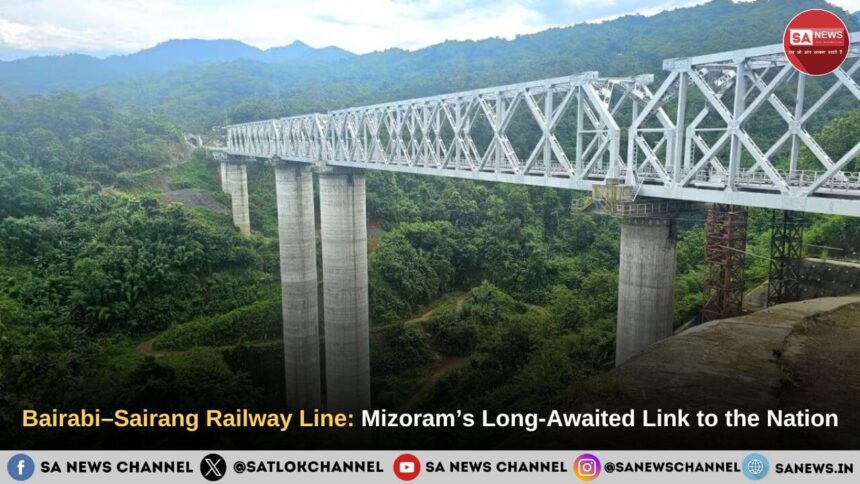For decades, Mizoram remained one of India’s few states without a direct railway connection to its capital. Nestled in the hills of Northeast India, Aizawl was accessible only by road and air, limiting economic growth, mobility, and integration with the rest of the country. That changed in September 2025, when the Bairabi–Sairang railway line was officially completed, linking Aizawl to the national railway grid for the first time. This 51.38 km stretch is more than a transport upgrade—it’s a symbol of inclusion, resilience, and strategic foresight.
Project Overview
The Bairabi–Sairang railway line was sanctioned in 2008–09 under the Ministry of Railways and executed by Northeast Frontier Railway. After years of challenging terrain, engineering hurdles, and logistical delays, the project was completed at a cost of ₹8,070 crore. The line begins at Bairabi, Mizoram’s only existing railhead, and ends at Sairang, just 20 km from Aizawl.
The route includes:
- 48 tunnels totaling 12.85 km in length
- 55 major bridges, including the iconic Bridge No. 196, which stands 114 metres tall—making it one of the tallest railway bridges in India
- Four stations: Hortoki, Kawnpui, Mualkhang, and Sairang
This engineering feat cuts through rugged hills and deep valleys, showcasing India’s growing capability in executing complex infrastructure projects in remote regions.
Economic and Social Impact
The completion of the railway line is expected to transform Mizoram’s economy and social landscape in several key ways:
1. Boost to Local Industries
Mizoram’s economy relies heavily on agriculture, handicrafts, and small-scale industries. With improved connectivity:
- Farmers can transport perishable goods like pineapples, oranges, turmeric, and ginger more efficiently, reducing spoilage and increasing profits
- Artisans and small businesses gain access to larger markets for bamboo products, handwoven textiles, and traditional crafts
- Logistics costs are expected to drop by 20–30 percent, making local products more competitive
2. Tourism Growth
Mizoram’s scenic beauty, cultural richness, and eco-tourism potential have long been underutilized due to poor connectivity. The new railway line is expected to increase tourist arrivals by 40–50 percent over the next five years. With easier access from Guwahati, Kolkata, and Delhi, Mizoram could become a major destination for domestic and international travelers seeking offbeat experiences.
3. Improved Mobility
The launch of Mizoram’s first Rajdhani Express from Sairang to Delhi marks a significant upgrade in mobility. New routes to Guwahati and Kolkata further enhance travel options for students, patients, and professionals. For many residents, this means more affordable and reliable access to education, healthcare, and employment opportunities across India.
4. Job Creation
The railway line is expected to generate between 3,000 and 5,000 indirect jobs annually in sectors such as logistics, tourism, retail, and hospitality. Local youth will benefit from new employment avenues, while small towns along the route may see increased investment and urban development.
Strategic Significance
Beyond local benefits, the Bairabi–Sairang railway line plays a crucial role in India’s Act East Policy, which aims to strengthen ties with Southeast Asia. Mizoram shares a border with Myanmar, and improved connectivity could facilitate cross-border trade, cultural exchange, and regional cooperation.
Also Read: Railway RPF Constable Exam Date 2025 Released: Check The Direct Link Here!
The railway also enhances national security by improving troop and supply movement in border areas. In a region often overlooked in mainstream development narratives, this project sends a strong message about inclusion and strategic investment.
Environmental Considerations
While infrastructure development in ecologically sensitive areas often raises concerns, the Bairabi–Sairang project incorporated several mitigation measures:
- Use of pre-fabricated structures to reduce on-site construction impact
- Reforestation efforts along the route
- Noise and vibration control in tunnel zones to protect wildlife habitats
Balancing development with sustainability remains a challenge, but the project sets a precedent for responsible infrastructure planning in the Northeast.
Conclusion
The Bairabi–Sairang railway line is not just a physical connection—it’s a bridge to opportunity. For Mizoram, it represents long-awaited recognition, integration, and empowerment. For India, it’s a strategic investment in inclusive growth and regional stability. And for young readers and future leaders, it’s a reminder that infrastructure isn’t just about roads and rails—it’s about people, potential, and progress.
As trains begin to roll through Mizoram’s hills, they carry more than passengers. They carry hope, ambition, and the promise of a more connected future.
just as a railway line connects remote places to the nation, true spiritual knowledge connects the soul to its Supreme Source—God Kabir Sahib. Without this divine connection, the soul remains isolated in the cycle of birth and death, just as Mizoram once remained cut off from the rest of the country.
Satgyan teaches that rituals, blind faith, and temporary material growth cannot provide lasting peace, just as roads and flights alone could not fully integrate Mizoram. Only the true path, revealed by a Tatvdarshi Saint, ensures complete liberation. Just as the railway line opens doors to economic, social, and cultural prosperity, Satgyan opens the way to eternal happiness, unity, and salvation in Satlok, the eternal abode of the Supreme God.
For more, visit Sant Rampal Ji Maharaj’s official YouTube channel: Sant Rampal Ji Maharaj YouTube









